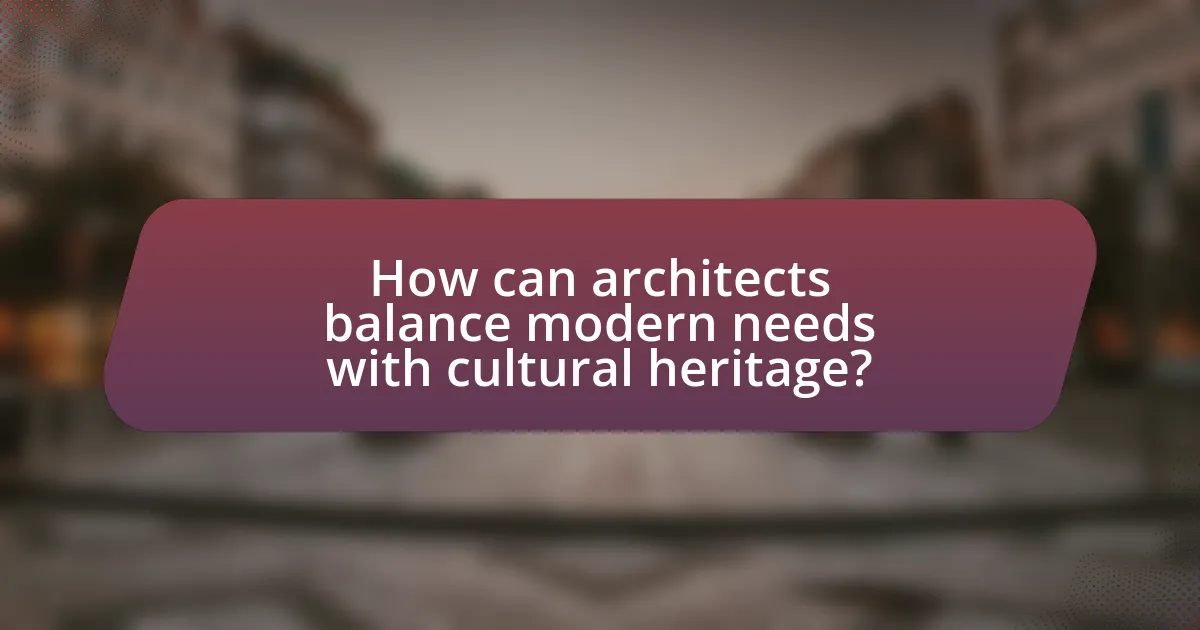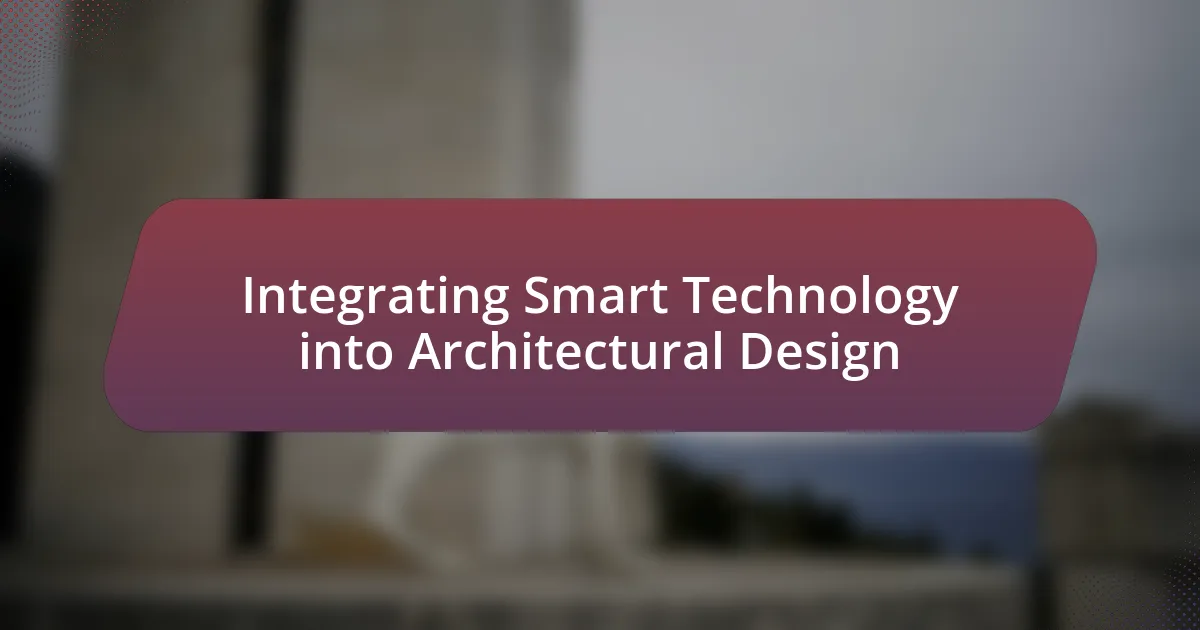The article examines the significant influence of cultural heritage on modern architectural practices, highlighting how historical styles, materials, and techniques shape contemporary designs. It discusses the integration of traditional motifs and local materials, emphasizing the importance of cultural identity in architecture. Key elements such as local craftsmanship, historical architectural styles, and cultural symbolism are explored, along with the role of community engagement in ensuring designs resonate with local narratives. The article also addresses challenges architects face in balancing modern needs with cultural preservation and the impact of globalization on architectural integrity. Successful examples, trends, and future directions in architecture that honor cultural heritage are presented, underscoring the necessity of authenticity and sustainability in design.

What is the Influence of Cultural Heritage on Modern Architectural Practices?
Cultural heritage significantly influences modern architectural practices by providing a framework of historical styles, materials, and techniques that architects draw upon to create contemporary designs. This influence is evident in the incorporation of traditional motifs, local materials, and sustainable practices that reflect the cultural identity of a region. For instance, the use of adobe in Southwestern U.S. architecture not only respects local climate conditions but also honors indigenous building traditions. Additionally, studies show that buildings designed with cultural context in mind often achieve greater community acceptance and aesthetic value, as seen in projects like the National Museum of African American History and Culture in Washington, D.C., which integrates African American cultural elements into its design.
How does cultural heritage shape architectural design today?
Cultural heritage significantly shapes architectural design today by influencing aesthetics, materials, and construction techniques. For instance, many contemporary buildings incorporate traditional motifs and styles that reflect local history and identity, such as the use of indigenous materials and craftsmanship. This practice not only preserves cultural narratives but also fosters a sense of belonging within communities. Research indicates that architecture that resonates with cultural heritage can enhance social cohesion and community pride, as seen in projects like the National Museum of African American History and Culture in Washington, D.C., which integrates African American cultural elements into its design. Thus, cultural heritage remains a vital component in the evolution of modern architectural practices, ensuring that new constructions honor and reflect the historical context of their environments.
What elements of cultural heritage are most influential in modern architecture?
Elements of cultural heritage that are most influential in modern architecture include traditional building materials, local craftsmanship, historical architectural styles, and cultural symbolism. Traditional building materials, such as adobe, timber, and stone, are often integrated into contemporary designs to create a sense of place and continuity with the past. Local craftsmanship reflects regional techniques and artistry, enhancing the uniqueness of modern structures. Historical architectural styles, such as Gothic, Baroque, or vernacular designs, inform modern aesthetics and functional approaches, often resulting in hybrid forms that respect historical context while embracing innovation. Cultural symbolism, which encompasses motifs, patterns, and colors significant to a community, is frequently employed to convey identity and heritage in modern architectural projects. These elements collectively shape the identity of modern architecture, ensuring that it resonates with cultural narratives and local histories.
How do architects interpret cultural heritage in their designs?
Architects interpret cultural heritage in their designs by integrating historical styles, materials, and local traditions to create spaces that reflect the identity of a community. This approach often involves studying the architectural elements of historical buildings, such as ornamentation, layout, and spatial organization, to ensure that new constructions resonate with the cultural context. For instance, the use of traditional materials like adobe in Southwestern U.S. architecture not only honors local heritage but also enhances sustainability by utilizing resources that are readily available in the environment. Additionally, architects may engage with local communities to understand their cultural narratives, ensuring that the designs are not only aesthetically pleasing but also culturally significant. This practice is evident in projects like the National Museum of African American History and Culture in Washington, D.C., which incorporates African American cultural motifs and storytelling elements, thereby reinforcing the connection between architecture and cultural identity.
Why is understanding cultural heritage important for architects?
Understanding cultural heritage is crucial for architects because it informs design choices that resonate with local identity and history. By integrating elements of cultural heritage, architects create spaces that reflect the values, traditions, and aesthetics of a community, fostering a sense of belonging and continuity. For instance, the preservation of historical architectural styles in urban planning not only maintains the character of a place but also enhances its cultural significance, as seen in cities like Kyoto, where traditional wooden structures coexist with modern buildings. This approach not only respects the past but also enriches the architectural narrative, ensuring that new constructions are contextually relevant and culturally meaningful.
What role does cultural identity play in architectural practices?
Cultural identity significantly influences architectural practices by shaping design choices, materials, and spatial organization. Architects often draw inspiration from local traditions, historical contexts, and community values, which reflect the cultural identity of a place. For instance, the use of indigenous materials and traditional construction techniques can be seen in various regions, such as adobe in Southwestern United States architecture or bamboo in Southeast Asian structures. This integration of cultural identity not only enhances the aesthetic appeal but also fosters a sense of belonging and continuity within communities, as evidenced by the preservation of historical sites that embody local heritage.
How can cultural heritage enhance the sustainability of modern architecture?
Cultural heritage enhances the sustainability of modern architecture by providing time-tested design principles and materials that promote environmental efficiency. For instance, traditional building techniques often utilize locally sourced materials and passive design strategies, which reduce energy consumption and minimize the carbon footprint. Research indicates that structures designed with cultural context in mind can achieve greater energy efficiency; for example, the use of thick walls and natural ventilation in Mediterranean architecture effectively maintains indoor temperatures without reliance on mechanical systems. This integration of heritage not only preserves local identity but also fosters resilience against climate change, as seen in the adaptive reuse of historical buildings that meet contemporary needs while conserving resources.
What challenges do architects face when integrating cultural heritage?
Architects face several challenges when integrating cultural heritage into their designs, primarily including balancing modern needs with historical preservation. This challenge arises from the necessity to respect and maintain the integrity of existing cultural sites while accommodating contemporary functionality and aesthetics. For instance, architects must navigate regulations and guidelines that protect heritage sites, which can limit design options and increase project complexity. Additionally, there is often a conflict between the community’s expectations for modern amenities and the desire to preserve traditional architectural styles, leading to potential resistance from stakeholders. Furthermore, the financial implications of restoration and preservation can strain budgets, making it difficult to achieve a harmonious integration of old and new elements.
How do conflicting cultural narratives impact architectural decisions?
Conflicting cultural narratives significantly impact architectural decisions by creating tensions between traditional values and contemporary design principles. Architects often face challenges in reconciling diverse cultural expectations, which can lead to design choices that either prioritize one narrative over another or seek a compromise that may dilute the integrity of both. For instance, in cities with rich historical backgrounds, such as Istanbul, the clash between modern developments and the preservation of historical sites has led to architectural solutions that attempt to blend modern aesthetics with traditional forms, as seen in the Zorlu Center, which integrates contemporary design while respecting the historical context. This dynamic illustrates how conflicting narratives can shape not only the aesthetic outcomes but also the functional aspects of architectural projects, ultimately influencing community acceptance and cultural relevance.
What are the risks of misrepresenting cultural heritage in architecture?
Misrepresenting cultural heritage in architecture can lead to a loss of authenticity and cultural identity. This misrepresentation often results in buildings that do not accurately reflect the historical, social, or cultural contexts from which they originate, potentially alienating communities and diminishing their connection to their heritage. For instance, the construction of faux-historical buildings can create a superficial understanding of a culture, leading to a commodification of heritage that prioritizes aesthetics over meaning. Additionally, such misrepresentation can provoke backlash from local communities, as seen in cases where developments disregard traditional architectural styles or cultural significance, leading to protests and calls for preservation. Ultimately, the risks include cultural erosion, community discontent, and a distorted public perception of cultural narratives.
How can architects effectively incorporate cultural heritage into their work?
Architects can effectively incorporate cultural heritage into their work by integrating traditional design elements, materials, and local craftsmanship that reflect the historical context of a region. This approach not only honors the cultural significance of the area but also enhances the identity of the built environment. For instance, the use of local stone and traditional construction techniques in buildings can create a sense of place and continuity with the past, as seen in the preservation efforts of historic districts worldwide. Additionally, architects can engage with local communities to understand their cultural narratives, ensuring that new designs resonate with the values and traditions of the inhabitants. This method has been validated by numerous case studies, such as the restoration of the Alhambra in Spain, which showcases how blending modern needs with historical context can lead to successful architectural outcomes.
What are some successful examples of cultural heritage in modern architecture?
Successful examples of cultural heritage in modern architecture include the National Museum of African American History and Culture in Washington, D.C., and the Louvre Abu Dhabi in the United Arab Emirates. The National Museum, designed by David Adjaye, incorporates African American cultural elements and symbolism, reflecting the historical and social narratives of African Americans. The Louvre Abu Dhabi, designed by Jean Nouvel, features a dome inspired by traditional Arabic architecture, symbolizing the connection between cultures and the region’s heritage. Both structures demonstrate how modern architecture can honor and integrate cultural heritage, enhancing the identity and narrative of their respective communities.
How do these examples reflect the values of their respective cultures?
These examples reflect the values of their respective cultures by showcasing how architectural designs embody cultural identity, historical significance, and social norms. For instance, traditional Japanese architecture emphasizes harmony with nature and simplicity, reflecting the cultural value of minimalism and respect for the environment. Similarly, the use of vibrant colors and intricate patterns in Moroccan architecture illustrates the cultural importance of community and celebration, as these designs often serve communal spaces. These architectural choices are not merely aesthetic; they are deeply rooted in the cultural narratives and historical contexts of their societies, reinforcing the connection between built environments and cultural heritage.
What lessons can be learned from these successful integrations?
Successful integrations of cultural heritage into modern architectural practices demonstrate the importance of contextual relevance, community engagement, and sustainability. These lessons highlight that architecture should reflect local identity and history, fostering a sense of belonging among residents. For instance, the incorporation of traditional materials and techniques in contemporary designs can enhance aesthetic value while promoting environmental sustainability. Research indicates that projects like the National Museum of African American History and Culture in Washington, D.C., designed by David Adjaye, effectively blend modern design with cultural narratives, showcasing how thoughtful integration can lead to both functional and meaningful spaces.

What are the key trends in modern architecture influenced by cultural heritage?
Key trends in modern architecture influenced by cultural heritage include the integration of traditional materials, adaptive reuse of historical structures, and the incorporation of local cultural motifs. Architects increasingly utilize materials such as clay, stone, and wood that reflect regional building practices, enhancing sustainability and cultural identity. Adaptive reuse, which involves repurposing old buildings for new functions, preserves historical significance while meeting contemporary needs; for example, the transformation of factories into residential lofts in urban areas. Additionally, the use of local cultural motifs in design elements fosters a sense of place and community, as seen in projects that incorporate indigenous patterns or symbols. These trends demonstrate a commitment to honoring cultural heritage while addressing modern architectural challenges.
How is globalization affecting the preservation of cultural heritage in architecture?
Globalization is significantly impacting the preservation of cultural heritage in architecture by promoting homogenization and the widespread adoption of international architectural styles. This phenomenon often leads to the neglect of local architectural traditions and practices, as seen in cities where modern skyscrapers replace historical buildings, diminishing the unique cultural identity of the area. For instance, UNESCO reported that many heritage sites are at risk due to urban development driven by global economic forces, which prioritize profit over preservation. Consequently, while globalization facilitates cultural exchange, it simultaneously poses challenges to maintaining the distinctiveness of local architectural heritage.
What strategies are being employed to maintain cultural integrity in a globalized world?
Strategies employed to maintain cultural integrity in a globalized world include the promotion of local traditions, the integration of indigenous knowledge in education, and the establishment of cultural preservation policies. Local traditions are often highlighted through community events and festivals that celebrate unique cultural practices, fostering a sense of identity and belonging. Educational institutions increasingly incorporate indigenous knowledge into their curricula, ensuring that younger generations understand and appreciate their cultural heritage. Additionally, governments and organizations implement cultural preservation policies that protect historical sites and promote traditional arts and crafts, as seen in UNESCO’s efforts to safeguard intangible cultural heritage. These strategies collectively contribute to the resilience of cultural identities amidst globalization.
How do local materials and techniques contribute to cultural heritage in architecture?
Local materials and techniques significantly contribute to cultural heritage in architecture by embodying the historical, environmental, and social contexts of a region. These materials, such as adobe in the Southwestern United States or bamboo in Southeast Asia, reflect the available resources and traditional craftsmanship of local communities. Techniques like dry-stone walling or thatching not only showcase unique building methods but also preserve ancestral knowledge and skills passed down through generations. For instance, the use of local stone in the construction of ancient castles in Europe demonstrates a direct connection to the landscape and cultural identity of the area. This integration of local materials and techniques fosters a sense of place and continuity, reinforcing community identity and heritage.
What role does technology play in preserving cultural heritage in architecture?
Technology plays a crucial role in preserving cultural heritage in architecture by enabling the documentation, restoration, and simulation of historical structures. Advanced tools such as 3D scanning and modeling allow for accurate digital representations of buildings, which can be used for analysis and restoration efforts. For instance, the use of Building Information Modeling (BIM) facilitates the management of historical data and construction processes, ensuring that renovations respect the original architectural intent. Additionally, technologies like virtual reality (VR) and augmented reality (AR) provide immersive experiences that educate the public about cultural heritage, enhancing appreciation and awareness. These technological applications are supported by numerous case studies, such as the restoration of the Notre-Dame Cathedral in Paris, where digital tools were employed to assess damage and plan reconstruction efforts effectively.
How can digital tools aid in the documentation of cultural heritage?
Digital tools can significantly aid in the documentation of cultural heritage by enabling precise data collection, visualization, and preservation. Technologies such as 3D scanning and photogrammetry allow for the accurate capture of physical artifacts and sites, creating detailed digital models that can be analyzed and shared globally. For instance, the use of Geographic Information Systems (GIS) facilitates the mapping of cultural sites, providing context and spatial relationships that enhance understanding. Additionally, digital archiving platforms enable the storage and accessibility of historical documents and images, ensuring that cultural narratives are preserved for future generations. These methods not only enhance the accuracy of documentation but also promote wider engagement and education regarding cultural heritage.
What innovations are emerging that blend technology with traditional architectural practices?
Emerging innovations that blend technology with traditional architectural practices include the use of Building Information Modeling (BIM), 3D printing, and augmented reality (AR). BIM allows architects to create detailed digital representations of buildings, integrating traditional design elements with modern construction techniques, which enhances collaboration and efficiency. 3D printing enables the creation of complex architectural forms that reflect traditional styles while utilizing sustainable materials, thus preserving cultural heritage. Augmented reality applications provide immersive experiences that allow stakeholders to visualize and interact with architectural designs in real-time, bridging the gap between historical context and contemporary needs. These technologies are reshaping how architects approach design, ensuring that cultural heritage is respected while embracing modern advancements.
What future directions can we expect for cultural heritage in architecture?
Future directions for cultural heritage in architecture include increased integration of technology, sustainable practices, and community engagement. The use of digital tools, such as Building Information Modeling (BIM) and virtual reality, allows for better preservation and representation of heritage sites, enhancing accessibility and education. Sustainable architecture is increasingly prioritizing the conservation of historical materials and techniques, aligning with global environmental goals. Furthermore, involving local communities in the design process ensures that cultural narratives are respected and reflected in new developments, fostering a sense of ownership and continuity. These trends are supported by initiatives like UNESCO’s World Heritage program, which emphasizes the importance of cultural heritage in sustainable development.
How might changing demographics influence architectural practices related to cultural heritage?
Changing demographics significantly influence architectural practices related to cultural heritage by necessitating the adaptation of designs to reflect the diverse cultural identities of emerging populations. As communities evolve, architects must consider the varying cultural backgrounds, traditions, and values of residents, which can lead to the integration of new materials, styles, and functions that resonate with these groups. For instance, in cities experiencing an influx of immigrants, architectural practices may incorporate elements from the newcomers’ cultures, such as communal spaces that reflect traditional gathering practices, thereby preserving and celebrating cultural heritage while fostering inclusivity. This trend is supported by studies indicating that architecture can enhance social cohesion and cultural identity, as seen in urban areas where multicultural influences have led to the creation of vibrant, culturally rich environments.
What potential developments could enhance the relationship between culture and architecture?
Integrating advanced technology, such as virtual reality and augmented reality, can significantly enhance the relationship between culture and architecture. These technologies allow architects and designers to create immersive experiences that reflect cultural narratives and historical contexts, enabling users to engage with architectural spaces in a meaningful way. For instance, the use of virtual reality in the reconstruction of historical sites can provide insights into cultural heritage, as demonstrated by projects like the virtual reconstruction of the ancient city of Pompeii, which helps users understand its historical significance and architectural styles. Additionally, incorporating sustainable materials and practices that resonate with local traditions can further strengthen this relationship, as seen in the use of rammed earth construction in various cultures, which not only reflects local aesthetics but also promotes environmental sustainability.

How can architects balance modern needs with cultural heritage?
Architects can balance modern needs with cultural heritage by integrating contemporary design principles with traditional architectural elements. This approach allows for the creation of spaces that respect historical context while meeting current functional requirements. For instance, the use of local materials and traditional construction techniques can enhance the aesthetic value of new buildings, as seen in projects like the National Museum of African American History and Culture in Washington, D.C., which incorporates elements reflective of African American culture. Additionally, adaptive reuse of historic structures, such as converting old factories into modern living spaces, exemplifies how architects can preserve cultural significance while addressing modern demands. This method not only maintains the historical narrative but also promotes sustainability by reducing the need for new materials.
What best practices should architects follow when integrating cultural heritage?
Architects should prioritize community engagement and thorough research when integrating cultural heritage into their designs. Engaging with local communities ensures that the architectural solutions reflect the values, traditions, and needs of the people who inhabit the space. Researching historical context and architectural styles relevant to the heritage site allows architects to create designs that respect and enhance the existing cultural landscape. For instance, the integration of traditional materials and techniques can preserve the authenticity of the heritage while meeting modern functional requirements. This approach not only honors the past but also fosters a sense of identity and continuity within the community.
How can community engagement improve the integration of cultural heritage in architecture?
Community engagement can significantly enhance the integration of cultural heritage in architecture by fostering collaboration between architects and local communities. This collaboration ensures that architectural designs reflect the historical, social, and cultural contexts of the area, leading to structures that resonate with the community’s identity. For instance, participatory design processes, where community members contribute their insights and preferences, have been shown to result in buildings that honor local traditions and materials, as evidenced by projects like the Community Design Collaborative in Philadelphia, which emphasizes local input in architectural planning. Such engagement not only preserves cultural heritage but also strengthens community ties and promotes a sense of ownership over the built environment.
What resources are available for architects to learn about cultural heritage?
Architects can access various resources to learn about cultural heritage, including academic journals, online courses, and specialized organizations. Academic journals such as the “Journal of Cultural Heritage” provide peer-reviewed articles that explore the intersection of architecture and cultural heritage. Online platforms like Coursera and edX offer courses on heritage conservation and cultural studies, enabling architects to gain knowledge from experts in the field. Additionally, organizations such as the International Council on Monuments and Sites (ICOMOS) provide guidelines, publications, and networking opportunities focused on preserving cultural heritage in architecture. These resources collectively enhance architects’ understanding of how cultural heritage influences modern architectural practices.
What are the common pitfalls to avoid in cultural heritage architecture?
Common pitfalls to avoid in cultural heritage architecture include neglecting historical context, using inappropriate materials, and failing to engage with the community. Neglecting historical context can lead to designs that clash with the original architectural style, undermining the integrity of the heritage site. For instance, the inappropriate use of modern materials, such as glass or steel, can detract from the authenticity of historical buildings, as seen in various restoration projects that have faced criticism for their lack of sensitivity to traditional craftsmanship. Additionally, failing to engage with the local community can result in designs that do not reflect the cultural significance of the site, leading to a disconnect between the architecture and its intended purpose. Engaging stakeholders ensures that the architectural interventions respect and enhance the cultural narrative, which is crucial for preserving heritage.
How can architects ensure authenticity in their designs?
Architects can ensure authenticity in their designs by deeply engaging with the cultural heritage of the location they are working in. This involves researching local materials, traditional construction techniques, and historical architectural styles that reflect the community’s identity. For instance, a study by the University of Cambridge highlights that incorporating local craftsmanship and sustainable materials not only honors the cultural context but also enhances the building’s connection to its environment. By prioritizing these elements, architects create designs that resonate with the local culture and history, thereby achieving authenticity.
What are the consequences of neglecting cultural context in architectural projects?
Neglecting cultural context in architectural projects can lead to designs that are aesthetically unappealing, socially disconnected, and functionally inappropriate. When architects disregard local traditions, values, and environmental conditions, the resulting structures may clash with the community’s identity, leading to public disapproval and a lack of engagement. For instance, the failure to incorporate local materials and building techniques can result in structures that are not only visually incongruent but also less sustainable, as they may not perform well in the local climate. Historical examples, such as the construction of modernist buildings in historic districts without regard for existing architectural styles, have often faced backlash and calls for demolition or redesign, demonstrating the importance of cultural sensitivity in architectural practice.
What practical tips can architects use to incorporate cultural heritage effectively?
Architects can effectively incorporate cultural heritage by conducting thorough research on local history, traditions, and architectural styles. This foundational understanding allows architects to create designs that resonate with the cultural identity of the community. For instance, integrating traditional materials and construction techniques can enhance authenticity; using locally sourced stone or wood reflects regional craftsmanship. Additionally, engaging with local communities through workshops or consultations ensures that the voices and values of the heritage are represented in the design process. This participatory approach not only fosters a sense of ownership but also aligns the project with the cultural narrative of the area. Furthermore, studying successful case studies, such as the restoration of historic buildings in cities like Kyoto, Japan, demonstrates how blending modern functionality with traditional aesthetics can yield harmonious results.





